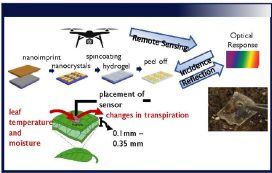New Sensors for Monitoring and Assessing Farming Conditions
Drought is well known as a threat because it often leads to increased crop stress resulting in lower crop yields, environmental damage, and economic injury to farmers. Researchers have developed novel sensor technology to be deployed on leaf surfaces that measures moisture and temperature levels, enabling precision monitoring of crop health. This research is being performed by a team from the NSF-funded Internet of Things for Precision Agriculture (IoT4Ag) Engineering Research Center headquartered at the University of Pennsylvania (Penn).
The Internet of things (IoT) describes physical objects with sensors, processing ability, software, and other technologies that connect and exchange data with other devices and systems over the Internet or other communications networks. IoT4Ag‘s research mission is to create and translate to practice IoT technologies for precision agriculture that will address the challenges of assuring food, energy, and water security for decades to come. The new sensors are part of the Center’s efforts to advance technology to increase crop production while minimizing the use of energy and water resources and the impact of agricultural practices on the environment. They make use of LEAFSENSE technology, which combines artificial intelligence and smart sensors to enable precision agriculture, optimizing productivity and reducing costs. The sensors will help farmers actively monitor leaf moisture and temperature levels, allowing them to be proactive and make informed decisions in crop cultivation before yields are permanently affected. They are cost-effective compared to current moisture sensors and do not require power. The new sensors enable remote monitoring of plant moisture and temperature at the canopy level, which can be used to identify early signs of crop stress, thereby improving crop yield and resiliency. Further, they are biodegradable and biocompatible, so they do not need to be retrieved from the field.
IoT4Ag unites faculty and students from Penn, Purdue University, the University of California-Merced, and the University of Florida with industry and government partners to transform agriculture. By 2050, the US population is estimated to grow to 400 million and the world population to 9.7 billion. Current agricultural practices account for 70% of global water use; energy use is one of the highest costs on a farm; and inefficient use of agrochemicals is altering Earth’s ecosystems. With finite arable land, water, and energy resources, ensuring food, energy, and water security will require new technologies to improve the efficiency of food production, create sustainable approaches to supply energy, and prevent water scarcity.
One of IoT4Ag’s research priorities is to map spatially and temporally the complex plant and environmental variables affecting crop yield and stress resilience by creating low-cost, zero-/near-zero power sensors distributable throughout the field and remotely interrogatable, as well as to advance robotics and on-board sensor suites for direct biotic crop and abiotic environmental observation and indirect examination of distributed sensors. Colorimetric sensors are a class of optical sensors that change their color when influenced by external stimuli. Any change in a physical or chemical environment can be considered such a stimulus. IoT4Ag’s new sensing platform allows for insights into moisture and temperatures at the individual plant level, which is critical to crop success.



